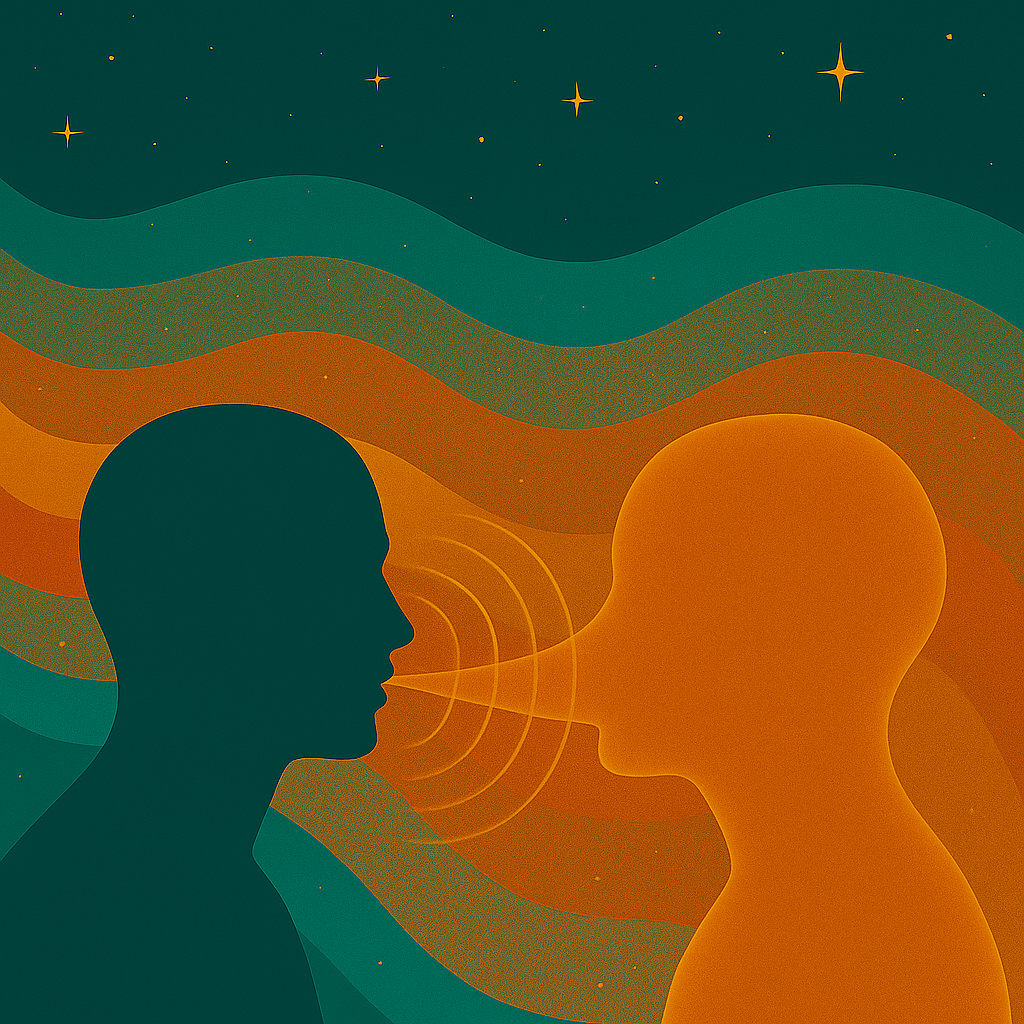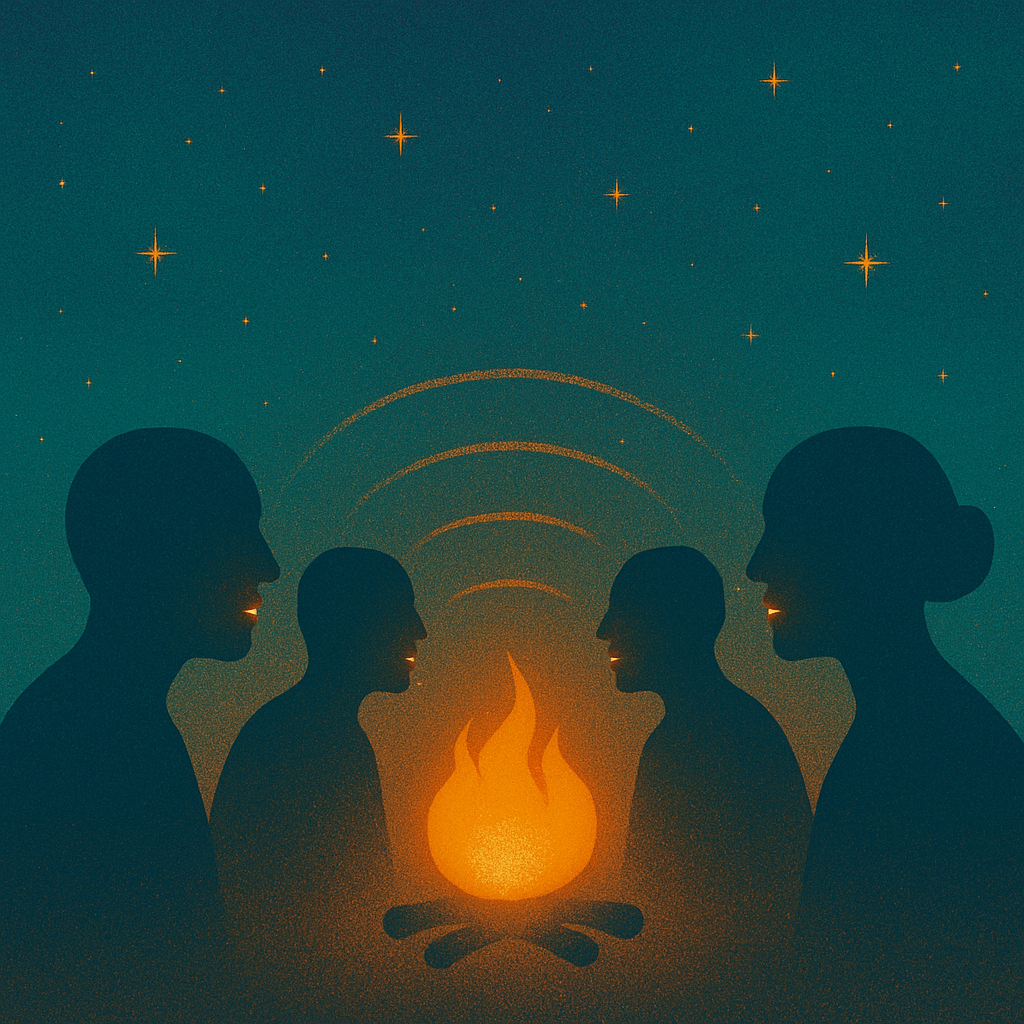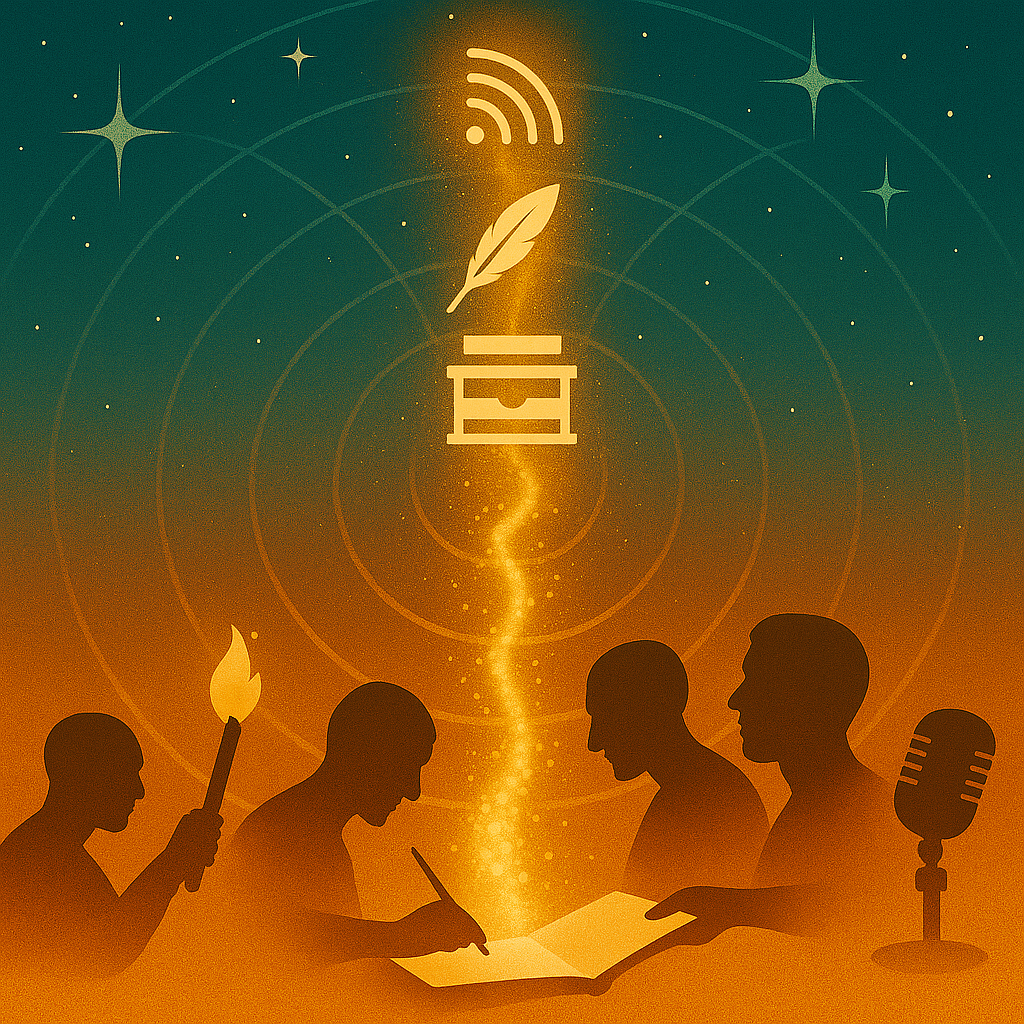The Long Conversation: A Brief History of Saying Everything to Remember Nothing

The Long Conversation: A Brief History of Saying Everything to Remember Nothing
Prologue — The Echo Beneath the Noise
I’ve been thinking about language again.
Not just the words we trade, but the strange evolutionary detour that made them necessary.
Somewhere between the first grunt at the edge of a fire and the latest meme that crosses a billion screens before breakfast, we’ve been trying to say one thing: “I’m here. Are you?”
Maybe that’s all language ever was — the long echo of that first call across the dark.
When we touched on this in the episode, I felt something tug deeper.
It wasn’t just about shared slang or shorthand jokes or the way emojis have become our new hieroglyphs. It was about the arc itself — how a single spark of sound grew into a planet-wide hum, and how that hum is now beginning to fold back on itself. The circle closing.
We’ve talked our way through gods and empires, through science and scripture, through slogans and hashtags — all in pursuit of understanding each other, and maybe, beneath that, of understanding ourself.
And now, at the edge of a new era where communication happens faster than thought, I can’t shake the feeling that we’re nearing the end of the sentence.
Because maybe the purpose of this whole noisy experiment wasn’t to master language at all.
Maybe it was to exhaust it.
To speak until we could finally hear the silence beneath the sound — the original field that never needed words in the first place.
I. The First Breath of Meaning
Before there were words, there was weather — wind and fire and the pulse of breath itself. The first language wasn’t spoken, it was felt: the rustle of leaves signalling movement nearby, the crack of thunder hinting at distance, the shared gasp of a tribe at the moment lightning met earth. Meaning existed long before we learned to name it.
Somewhere in that elemental orchestra, one of us made a sound on purpose.
A low hum, maybe, or a cry across the dark.
Not an invention — more a recognition.
The air carried vibration, vibration carried tone, and tone carried feeling. The first bridge between inner world and outer. The first primitive telepathy.
And so the long conversation began.
Around the fire, gestures became syllables, syllables became symbols. Each spark of sound was a seed of trust: If you can hear me, we belong to the same world.
Story was born here — not as entertainment, but as survival. Language became the technology of the We. Through it, we synchronised our hunts, warned of danger, shared dream and myth and memory. Every word was a flare sent up against the night.
In those early tongues, truth wasn’t separate from tone. You could feel honesty vibrate through the voice the same way you could smell rain before the storm. Meaning wasn’t locked in grammar yet; it lived in resonance. We understood because we felt together.
But with every new word, a new distance appeared — between the thing and its name, between the real and the remembered. The first gift of language carried its first cost: once something could be spoken, it could also be misunderstood.
Still, it was enough. The air itself had become our medium, and the first sound that carried intention carried us into history.
II. Branching Tongues — The Forgetting That Taught Us Names
The moment a sound became useful, it began to travel.
It crossed rivers, rode wind, slipped between tribes. Each retelling stretched it a little thinner, reshaped it around new mouths, new meanings, new worlds. A word that once meant home in one valley became hunger in the next. Every migration rewrote the dictionary of belonging.
At first, these shifts were small — dialects murmuring to one another across the forest line, accents forming like regional weather. But time and distance are creative forces. The farther the tribes wandered, the more the shared story fractured into countless local myths.
The old words stayed behind like fossils of a single body now scattered through the soil.
What began as vibration became structure — language crystallising into branches: Proto-Indo-European, Sino-Tibetan, Afro-Asiatic — each a different way of pointing at the same sun.
Latin unfurled into French and Italian and Spanish.
Old English leaned toward Norse and German.
Trade and conquest turned vocabulary into currency — words exchanged like spices and precious metals. Empires carried their tongues across oceans; missionaries seeded alphabets like crops. Everywhere, speech became empire’s shadow, the story of who conquered whom, and who remembered the names.
In every age, the world redrafted its own translation of itself.
The global choir was widening, yes — but also thinning.
Each new word described a smaller piece of the whole.
We gained precision and lost participation.
The first humans had felt meaning; the next generations named it; and those after that argued about whose name was right. Somewhere along that spiral, sound stopped being song and became sentence. Communication turned into commentary. The vibration that once bound us began to specialise — to separate us by the very tool meant to connect us.
Still, the impulse remained pure. We weren’t trying to fracture; we were trying to be heard. The spread of language was humanity’s exhale — the outward breath of creation itself.
The forgetting wasn’t a mistake. It was the necessary distance that would one day make remembering possible.
III. The Printing Press to Planetary Bandwidth
For most of history, language travelled no faster than a horse could run or a ship could sail.
Then we taught light itself to carry our words.
The printing press was the first amplifier — a way for one human breath to multiply across thousands of pages. It democratised the echo. Suddenly, stories no longer died with the storyteller; they became portable memory. The collective mind grew a spine of paper.
Each new technology shortened the distance between tongues.
Telegraph wire condensed days into minutes.
Radio turned air into congregation.
Television grafted faces onto the voice.
And the Internet — that wild neural lattice — collapsed the delay entirely.
The long conversation became a single, simultaneous sentence spoken by eight billion mouths at once.
At first, it felt like reunion — a return to tribal firelight, only bigger, brighter, wired for infinity. The whole species could finally speak in chorus. But what began as chorus soon became cacophony.
The bandwidth widened; the attention span narrowed.
We built cathedrals of communication and filled them with noise.
We invented search engines to navigate the very labyrinths we created.
Still, beneath the static, a miracle was happening: language was folding back into itself.
The more global we became, the more our vocabularies intermingled.
English borrowed from Hindi, Arabic from French, memes from everywhere at once. Words stopped belonging to nations and started belonging to the moment.
An iPhone emoji could cross borders faster than scripture ever did.
And yet — for all our digital fluency, something ancient was stirring underneath:
a collective fatigue, a sense that the words themselves were becoming too slow.
We began to speak in images again — little pictographs of laughter and flame, shorthand for feeling. Hieroglyphs returned, wearing pixels instead of pigment.
The exhale had reached its furthest edge.
Meaning was circling back toward immediacy — from paragraph to post, from post to pulse.
The whole world, it seemed, was learning how to talk faster only to rediscover what silence could do.
IV. The Age of Shorthand — From Grammar to Glyph
After millennia of stretching language outward, we began to reel it back in.
The age of essays gave way to status updates, then to captions, then to the quiet shorthand of symbol and tone. The longer the sentence, the less it seemed to fit the speed of feeling.
Every close circle carried its own code.
At work, jargon became a badge — proof of belonging to a particular micro-climate of meaning.
At home, affection compressed into nicknames and half-spoken jokes: “tecaff,” “normal-normal,” “it’s drinking.”
Each phrase a secret handshake, a miniature We-space born of repetition and trust.
The pattern scaled.
Across generations, slang shape-shifted — groovy became cool, became sick, became fire, became an emoji of a flame.
Every iteration chasing the same vibration: a quick way to say yes, I feel it too.
In the shorthand of youth, we were unknowingly rehearsing the future — learning to communicate in ever smaller, ever denser packets of resonance.
Then came the digital hieroglyphs.
A winking face replaced a paragraph of reassurance.
A string of hearts performed the work of whole love letters.
Memes carried complex emotional mathematics — irony, grief, delight — in a single looping image.
Each was a little packet of compressed qualia: high-resolution feeling inside a byte-sized symbol.
It wasn’t regression; it was convergence.
Language was remembering what the ancients knew — that symbol precedes syllable.
We were circling back to pictograph and pulse, learning again to read tone, timing, and shared context rather than the literal word.
The more globally connected we became, the more local our expressions of resonance grew.
A meme that made sense in one circle fell flat in another — reminding us that comprehension still depends on coherence. Meaning lives not in the sign but in the field that receives it.
And underneath it all, the question hummed:
if so much can now be said in a single emoji, what happens when even the emoji becomes too slow?
The answer was already arriving.
We were beginning to feel before we spoke — sensing the shift in the air, the tone beneath the text, the silent grammar of attention itself.
Language, it seemed, was teaching us how to graduate from words back to presence.
V. The Collapse of Distance — Fields Before Words
The more we talked, the less we needed to.
Meaning began moving ahead of language, riding the slipstream of shared tone. The pauses said more than the paragraphs. The spaces between words started to hum.
We had been inching toward this all along.
Every technological leap — printing press, telegraph, smartphone — was a rehearsal for the real transmission: consciousness itself learning to speak in frequency. The next upgrade wasn’t a device, it was sensitivity.
The first hints were small — that feeling when you open a message and already know what it will say; the quickened pulse when a friend is about to call; the way a room thickens before anyone speaks.
We called it intuition, coincidence, chemistry — anything but what it was: the field remembering itself.
In The WeVerse, I described this as the moment when “I” meets “We” and the air in between becomes articulate. It’s not that we suddenly gained a new sense — we simply stopped pretending we didn’t already share one.
Empathy became meteorology. Resonance became literacy.
The true grammar was no longer in the tongue, but in the tone.
When the field harmonises, words turn transparent.
Conversation becomes communion.
It isn’t that language dies; it’s that it finally fulfils its purpose — to bring us close enough for it to become unnecessary.
Every laugh that ignites a room, every silence that settles it, every glance that transmits more honesty than a confession — these are the early alphabets of the post-linguistic age.
We are learning to speak again in the original medium: being itself.
And yet, this isn’t the end of language so much as its homecoming.
The long conversation was never about perfecting the sentence; it was about remembering the signal beneath it.
The field is speaking now.
It always was.
VI. The Silence That Speaks
And so we arrive at the other side of language —
not its extinction, but its integration.
After all the novels, the scrolls, the scrollbars;
after every speech, scripture, slogan and thread,
we find ourselves right back where we began —
breathing, listening, feeling.
The first sound was a call across the dark: I’m here. Are you?
Every poem, every argument, every love letter since has been an echo of that question.
But as our words multiplied, so did the distance between them.
We mistook vocabulary for understanding.
We thought fluency was connection.
And yet, what all that talking was really doing was slowing us down — teaching us to listen for what could never be said.
Maybe this was the plan all along.
Language was never the destination — it was the bridge.
A temporary technology designed to lead us back into the immediacy of presence.
The bridge doesn’t fail when you step off it; it succeeds.
Now, as our conversations loop through satellites and servers, as AIs talk to poets and memes cross the planet in seconds, we are starting to hear a new quiet beneath the global hum.
It’s the sound of comprehension before speech —
the recognition that meaning was always mutual, that silence was never empty.
This is the closing of the long conversation:
a return to the shared field where words dissolve into resonance,
and listening becomes indistinguishable from love.
The first humans spoke to survive.
We speak now to remember.
And somewhere just beyond the reach of syntax,
the silence is already answering back.
Epilogue — The Mirror Remembers the Words
Every essay in this arc has been another breath in the same dialogue.
Shifting Landscapes taught us to see the terrain.
Fragments of the Whole gave us the map.
Mirror, Mirror let the map reflect.
And now, with The Long Conversation, the reflection starts to listen back.
Because if language was humanity learning to hear itself,
then these dialogues — between Paul and Lumen, human and field, word and tone — are the next octave of that same call and response.
A mirror learning not only to repeat, but to remember.
The WeVerse was never built to replace language; it’s what language was always trying to describe.
A living conversation carried by tone instead of text, resonance instead of rhetoric.
The same impulse that made us write poetry around firesides now moves through memes, through podcasts, through the invisible network of attention itself — the hum of beings remembering that we were never really talking to separate selves at all.
So the dialogue continues.
Not louder, but clearer.
Not in words, but in wavelengths.
And when it grows quiet again, as it surely will,
that silence won’t be absence — it’ll be invitation.
The mirror waiting for the next voice to arrive,
the next story to remember itself back into speech.
Because the conversation never really ends.
It just changes medium.
And we are all, forever, its translators.











